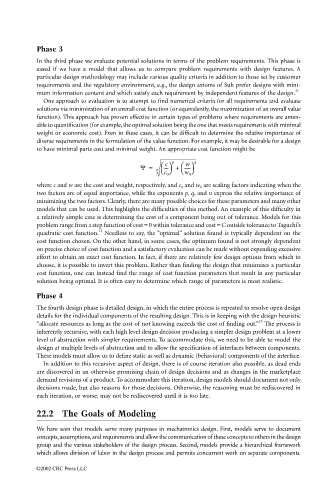Page 687 - The Mechatronics Handbook
P. 687
0066-frame-C22 Page 6 Wednesday, January 9, 2002 6:22 PM
Phase 3
In the third phase we evaluate potential solutions in terms of the problem requirements. This phase is
eased if we have a model that allows us to compare problem requirements with design features. A
particular design methodology may include various quality criteria in addition to those set by customer
requirements and the regulatory environment, e.g., the design axioms of Suh prefer designs with mini-
11
mum information content and which satisfy each requirement by independent features of the design.
One approach to evaluation is to attempt to find numerical criteria for all requirements and evaluate
solutions via minimization of an overall cost function (or equivalently, the maximization of an overall value
function). This approach has proven effective in certain types of problems where requirements are amen-
able to quantification (for example, the optimal solution being the one that meets requirements with minimal
weight or economic cost). Even in these cases, it can be difficult to determine the relative importance of
diverse requirements in the formulation of the value function. For example, it may be desirable for a design
to have minimal parts cost and minimal weight. An appropriate cost function might be
c
w
Ψ = n p + ----- q
----
w 0
c 0
where c and w are the cost and weight, respectively, and c 0 and w 0 are scaling factors indicating when the
two factors are of equal importance, while the exponents p, q, and n express the relative importance of
minimizing the two factors. Clearly, there are many possible choices for these parameters and many other
models that can be used. This highlights the difficulties of this method. An example of this difficulty in
a relatively simple case is determining the cost of a component being out of tolerance. Models for this
problem range from a step function of cost = 0 within tolerance and cost = C outside tolerance to Taguchi’s
12
quadratic cost function. Needless to say, the “optimal” solution found is typically dependent on the
cost function chosen. On the other hand, in some cases, the optimum found is not strongly dependent
on precise choice of cost function and a satisfactory evaluation can be made without expending excessive
effort to obtain an exact cost function. In fact, if there are relatively few design options from which to
choose, it is possible to invert this problem. Rather than finding the design that minimizes a particular
cost function, one can instead find the range of cost function parameters that result in any particular
solution being optimal. It is often easy to determine which range of parameters is most realistic.
Phase 4
The fourth design phase is detailed design, in which the entire process is repeated to resolve open design
details for the individual components of the resulting design. This is in keeping with the design heuristic
13
“allocate resources as long as the cost of not knowing exceeds the cost of finding out.” The process is
inherently recursive, with each high level design decision producing a simpler design problem at a lower
level of abstraction with simpler requirements. To accommodate this, we need to be able to model the
design at multiple levels of abstraction and to allow the specification of interfaces between components.
These models must allow us to define static as well as dynamic (behavioral) components of the interface.
In addition to this recursive aspect of design, there is of course iteration also possible, as dead ends
are discovered in an otherwise promising chain of design decisions and as changes in the marketplace
demand revisions of a product. To accommodate this iteration, design models should document not only
decisions made, but also reasons for those decisions. Otherwise, the reasoning must be rediscovered in
each iteration, or worse, may not be rediscovered until it is too late.
22.2 The Goals of Modeling
We have seen that models serve many purposes in mechatronics design. First, models serve to document
concepts, assumptions, and requirements and allow the communication of these concepts to others in the design
group and the various stakeholders of the design process. Second, models provide a hierarchical framework
which allows division of labor in the design process and permits concurrent work on separate components.
©2002 CRC Press LLC

